Tag : voices
April 2, 2019 by admin
Taking on the Boys’ Club
Years ago a friend of mine came to visit Los Angeles. During the course of conversation he mentioned that one of my long-time client organizations, with which I was still deeply involved, was going to be changing its entire mode of operation.
“I hadn’t heard anything about that,” I said.
“…Oh, I’m sure they’ll tell you soon. It was just a small group of us they told while we were at [insert the name of your favorite Jewish conference] a month ago.”
“I was also at that conference,” I said. “When did that happen?”
“Oh, it was after hours, while a group of us were in the hotel hot tub,” he said, naming a group of about five men of varying ages and ranges of Jewish professional experience, half of whom had less direct connections with the project than I did.
ESTHER D. KUSTANOWITZ, “Dismantling the Jewish Organizational Boys’ Club, One Hot Tub at a Time,” in eJewish Philanthropy.
- No Comments
April 2, 2019 by admin
The Persian Singer
Growing up in the 1970s in Queens, New York, as the daughter of Jewish immigrants from Iran, I was unable to articulate how I felt different from the other kids in my public elementary school: I could tell my teacher, Mrs. Rice, loved me, but I had never been called “bubbeleh” before. There were plenty of Jewish kids, but none whose families, like mine, ate rice during Passover.
One afternoon, in 1979, after the Iranian Revolution, I felt the sting of my differentness when a boy turned to me and hissed, “You, Iranian!”
The upheaval of that revolution scattered tens of thousands of Iranian Jews away from their country, most to the United States or Israel.
While I felt out of place in Queens, across the globe, in Israel, Maureen Neheder was feeling different from those around her too. Just two years old when the coup hit Iran, her family had moved from Iran to Israel, where her father soon abandoned her mother with two small children… While Maureen was piecing together her identity and musical heritage, I was growing aspects of my American, Persian, Jewish, and feminist identities in spurts: I achieved oral fluency in Farsi but cannot read and write the language; I learned to read and chant Hebrew tefillot and leyn Torah, but do not speak Hebrew; I learned Persian cuisine, dance, music, poetry, and cinema; I graduated from a women’s college and earned a law degree. And then Maureen Nehedar came into my life.
She traveled from Israel recently to perform at my synagogue. She is a critical success in Israel, known for her voice, compositions, arrangements and scholarship, with her albums “Gandom” and “Asleep in the Bosom of Childhood” glowingly reviewed. Nehedar performed for hundreds of men, women and children at a concert, then again for a large group of elderly Persian Jewish immigrants, and again at a talk she gave in my home. During each performance, audiences were transfixed. Many attendees wept silently as they joined her in singing once-familiar songs, their memories of Iran flooding back.
Perhaps it is not a surprise that her music evokes visceral emotions in those displaced by the Iranian Revolution. For me, having never even been to Iran, her performance was less about memories than about current possibilities: Maureen Nehedar affirms that the melding of the Persian, Jewish, American and feminist identities I have aspired to is possible—and beautiful.
- No Comments
April 2, 2019 by admin
Raised on Intersectionality, What’s a Teen to Do?
“And” is the most important word in the English language. It’s the linguistic equivalent of coalition building. It can build on an existing sentence, and more importantly, it can glue opposing truths together in one sentence, allowing messy realities to coexist. I’m Jewish and bisexual and feminist and Zionist, and I support Palestinian human rights, and I believe Black Lives Matter. All of these identities are central to who I am, and no single one undermines the other.
It makes sense, then, that over the course of my high school career, I fell in love with the concept of intersectionality. I attended Seeds of Peace International Camp where I engaged in raw and emotional dialogue with Palestinian and Israeli teens, and thought critically about my community’s role in oppressing Palestinians. I learned about Zionism with nuance in my “Dual-Narratives of the Middle East” history class. I attend a high school named after Rabbi Abraham Joshua Heschel, which celebrates his commitment to Civil Rights and his work alongside Dr. King. I learned and wrote about Jewish Feminist history with the Jewish Women’s Archive. I used my 11th grade research project to explore the role of Black women in the feminist and Civil Rights Movements. These combined influences forced me to see the necessity of a theory for social organizing that embraces the plurality, the “and-ness” of an identity.
Yet, in the wake of this year’s controversies, this word that has for so long made me feel visible is now being misinterpreted to erase me. Jewish writers write articles accusing me of anti-Semitism for supporting the Women’s March and intersectional feminism despite anti-Semitism in the movement. Feminist writers accuse me of phony allyship for foregrounding anti- Semitism. Each of these groups wants me to privilege one identity over the other, but intersectionality taught me that this was not only unnecessary, but impossible.
Although the recent controversy has felt painful and personal, I will continue to participate in movements like the Women’s March. Rather than taking myself out of the conversation, I will bring my full self to the table, Judaism, Zionism, and all. Maybe intersectionality is too long and complicated a word. Why use seventeen letters when you only need three? I’m Jewish and bisexual and Feminist and Zionist, and I support Palestinian human rights, and I believe Black Lives Matter. And I know better than to choose one over the other.
- No Comments
October 7, 2014 by admin
My Sister is So Silly
Lilith contributing editor Rachel Kranson, a historian at the University of Pittsburgh who is researching American Jewish life in the 1950s: “I’ve been looking through issues of Women’s League Outlook, the magazine for Conservative congregations’ sisterhoods. In a 1953 issue, I came across this little gem of a poem by Sadie Rose Weilerstein, author of the beloved Kton Ton books.
My Sister Is So Silly
My sister is so silly —
Of course, she’s only three —
She wants to wear a yarmolke
And tsitsis just like me.
“But girls don’t wear a yarmolke,”
I tell her ‘cause its true.
She simply puts one on her head
And says, “I do.”
From The Singing Way by Sadie Rose Weilerstein (1946).
- No Comments
October 7, 2014 by admin
Trigger Warnings
Unless you spend much time sitting in a college classroom or browsing through certain precincts of the Internet, it’s possible you had not heard of trigger warnings until a few weeks ago, when they made an appearance in the Times. The newspaper explained that the term refers to preemptive alerts, issued by a professor or an institution at the request of students, indicating that material presented in class might be sufficiently graphic to spark symptoms of post-traumatic-stress disorder ….
…It is hard to read through a fraction of the #YesAllWomen posts [the hashtag embraced as a vehicle for drawing attention to the pervasiveness of sexualized violence against women] without feeling shaken, whether by the relief of recognition or by the shock of ignorance dispelled. (If one is old enough to have participated in student-led Take Back the Night marches three decades ago, it is also impossible to read the posts without drawing the demoralizing conclusion that the night remains in hostile possession.
The trigger-warning debate may, by comparison, seem esoteric; but both it and #YesAllWomen express a larger cultural preoccupation with achieving safety, and a fear of living in its absence. The hope that safety might be found as in a therapist’s office, in a classroom where literature is being taught is in direct contradiction to one purpose of literature, which is to give expression through art to difficult and discomfiting ideas, and thereby to enlarge the reader’s experience and comprehension. The classroom can never be an entirely safe space, nor, probably, should it be. But it’s difficult to fault those who hope that it might be, when the outside world constantly proves pervasively hostile, as well as, on occasion, horrifically violent.
Rebecca Mead, “Literature and Life,” in The Talk of the Town, The New Yorker, June 9 & 16, 2014.
- No Comments
October 7, 2014 by admin
Before the World Was Ready
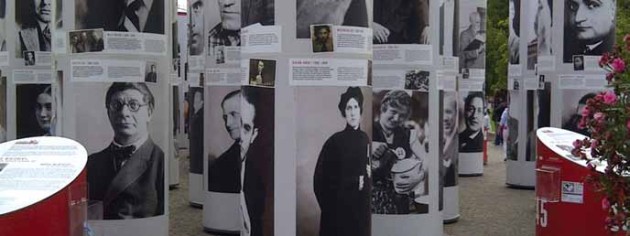
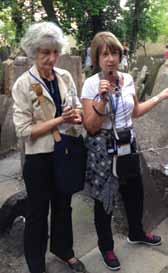
Rabbi Sandy Eisenberg Sasso (R) and guide in the Prauge Jewish Cemetery
The first women ordained as rabbis in the Unites States — Sally Priesand, Reform, 1972; Sandy Eisenberg Sasso, Reconstructionist, 1974; Amy Eilberg, Conservative, 1985; and Rabba Sara Hurwitz, Modern Orthodox, 2010 — traveled together to Berlin, Prague and Terezin in July to commemorate and learn more about the life of the first woman rabbi ever ordained. Lilith readers are familiar with the story of Regina Jonas, but new details surfaced during the poignant trip, which was organized by the American Jewish Archive and the Jewish Women’s Archive. Rabbi Eilberg shared these details on the Jewish Women’s Archive blog:
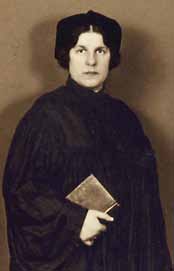
Rabbi Regina Jonas
“Regina Jonas, born into a poor Orthodox Jewish family in Berlin in 1902, dreamed of being a rabbi at the astonishing age of 11, far before the Jewish world was ready to support her aspirations. During the 1920s, she studied at the Academy for the Science of Judaism, taking all the same courses and exams required of rabbinical students, and wrote her rabbinic dissertation on the remarkable topic, ‘Can Women Serve as Rabbis?’ The faculty member who seemed ready to ordain her suddenly died and the institution agreed only to grant her the degree of ‘Academic Teacher of Religion.’ But in 1935, she was ordained as a rabbi by Rabbi Max Dienemann, representing the association of liberal (Reform) rabbis in Berlin. At first she was invited to work in schools, Jewish hospitals and nursing homes. As many rabbis fled the country, there was an unmet need for rabbis and Rabbi Jonas was able to serve in several synagogues that were desperate for rabbinic leadership as catastrophe approached. Regina Jonas was deported to Terezin in November of 1942, where she worked with psychologist Viktor Frankl in the camp before being deported to Auschwitz on October 12, 1944, where she was murdered.”
Rose Zoltek-Jick, a Boston law professor and Lilith board member who is the child of a Holocaust survivor, was one of the delegation of about 30 people who made the trip. She wrote, “It was far more meaningful than I could have ever anticipated. I knew that being surrounded by committed Jews would be the only way I could encounter the fears and ghosts that have shaped my being.
“[At the Berlin Jewish museum] it is unsettling (to say the least) to feel the clang of the door in Leibskind’s memorial that shuts you into a concrete tower with a crack of light and a ladder you could never reach; one descends into the maze of memorial stones created by Peter Eisenmann and realizes the hide and seek is not a game, if you are being pursued and you are not sure that there will be anyone waiting to find you at the other end. And it is quite another emotion to sit in Gestapo headquarters and know that you, a Jew, unlike one’s people just one generation ago, will walk out of there alive.
“At the same time, we had the honor of meeting Jews who have created a new rabbinic academy and its graduates who are serving in communities of small numbers all over Europe, and women rabbis who are creating the new norms that are necessary to reach out and spark any hope of renewal.”
- No Comments
October 7, 2014 by admin
Remembering Lauren Bacall
Lauren Bacall [née Betty Joan Perske] was born in Brooklyn to a Jewish family, but her Jewish-sounding name just wouldn’t cut it in the Hollywood of the 1940s and ’50s. She changed it to a version of her mother’s family name, Weinstein-Bacal.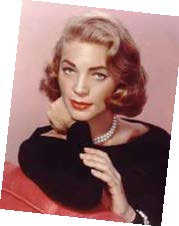
Bacall’s decision on her children’s baptism was unusual, according to NYU historian Hasia Diner, but indicative of her and husband Humphrey Bogart’s calculus that “being Jewish was too much of a liability in an environment in which one had to walk that tightrope” between being Jewish in private and appearing otherwise in public.
-From www.religionnews.com/2014/08/13/words-lauren-bacall-talks-jewish-identity.
This obituary tells more.
She also expressed impatience, especially in her later years, with the public’s continuing fascination with her romance with Bogart, even though she frequently said that their 12-year marriage was the happiest period of her life.
“I think I’ve damn well earned the right to be judged on my own,” she said in a 1970 interview with The New York Times.“It’s time I was allowed a life of my own, to be judged and thought of as a person, as me.”
From “Lauren Bacall, Sultry Movie Star, Dies at 89,” The New York Times, August 12, 2014.
- No Comments
October 7, 2014 by admin
It Was a Man’s War
During Operation Protective Edge, Israel’s military operation in Gaza this past summer, Israelis were glued to their screens. And more often than not, those screens showed images of men. The Israeli soldiers were men. The Hamas fighters were men. The pundits pontificating were men. And nearly all the Israeli and Palestinian casualties were men. When women did appear, they were often seen eulogizing, mourning, or struggling to reconcile with their reality. The images capture a sobering fact: Women in the region are suffering terribly from the consequences of decisions from which they are excluded. From start to finish, the latest Gaza conflict has largely been a man’s war. The Israeli negotiating team in Egypt does not include a single woman —not even Justice Minister Tzipi Livni, whose condition for joining the current governing coalition was that she head Israeli-Palestinian negotiations….. The story is the same on Israeli television and in the country’s newspapers. Fewer than 10 percent of all experts interviewed on news programs during the war have been women.
The sexism underlying women’s exclusion from security and military leadership
has found expression in some particularly troubling statements by senior officials and commentators. Moshe Feiglin, a member of Israel’s legislature, or Knesset, recently repri- manded lawmaker Aliza Lavie for discussing a bill on sexual violence, saying that wartime is no time to be “talking about things like flowers and sexual assault.” Bar-Ilan University professor Mordechai Kedar argued on Israeli radio that the only way to stop terrorists is to threaten to rape “their sister or their mother.” The implications have not gone unnoticed. “Women are sexually assaulted every day,” Amalia Schreier, a Lavie aide who had a hand in writing the sexual-assault bill, told Feiglin. “The delegitimization of this issue has the effect of hurting and placing at risk 50 percent of the population.”
…
The assumption that “real” soldiers are men is widespread in Israel. Army announcements and news stories about military recruitment routinely refer to “soldiers and their wives.” Volunteers and businesses have been preparing care packages for the troops fighting in Gaza that include razors and men’s underwear (last week, a mother of a female reservist issued a request for women-oriented care packages that include bras and tampons).
The conflict in Gaza has stoked broader sexism and misogyny, too. One Orthodox group in Israel set up a 24-hour “modesty hotline” and posted large, colorful signs telling women and girls that they could “stop” Hamas rockets by wearing long skirts, long sleeves, and thick stockings. Others maintain that women should uncover their bodies to save soldiers. The latest hostilities spawned a new Facebook group called “Standing With the IDF —Maintaining a Protective Edge” (literally, a “firm cliff,” another double entendre), the purpose of which is to show women disrobing with pro-IDF paint on their bodies —and to “boost morale.”
“The perception of the role of women in this war is identical to that of the early years of the state — only it might have been better then,” wrote attorney Vardit Avidan of the Tmura Legal Center for the Prevention of Discrimination, in a column titled “Be pretty and let the IDF win” for the Israeli news site Ynet. “When female soldiers receive packages with men’s underwear and aftershave, the message is that they are not supposed to be there.”
“Women are perceived as the supportive backbone, via two roles exclusively for them: the role of the worrying mother who cooks and sends soldiers food … and the role of the supportive woman via body and sexuality … supplying fighters with their ‘needs’,” Avidan added.
The dearth of women in decision-making positions means that perspectives from 50 percent of the population are largely missing —the 50 percent who have life experiences that would add tremendous value to the conversation. Not only do women suffer from war, but they are often left to pick up the pieces resulting from violent choices made by men.
…Knesset Member Naomi Chazan says,“Human security is not just security from military attacks. It’s physical, economic, and social security. It’s security to speak your mind even when you’re a minority opinion. It means that you wake up in the morning and you have some- thing to put on the table for your kids. It means you can walk the streets at night without being afraid of being attacked. It means tolerance for the other. It also means security against attacks. But the goal of security against attacks means creating a climate for human security under the broadest terms.”
…Chazan explained,“Our job as women is not to cry and pick up the pieces. It’s to do something to make a difference.”
from “Gaza: It’s a Man’s War,”The Atlantic Blog, August 7, 2014
- No Comments
October 7, 2014 by admin
Teaching by Example, Even in Mourning Her Murdered Son
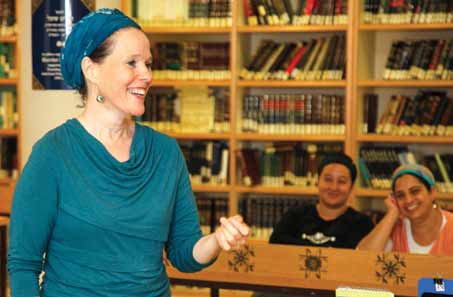 When cataclysmic events thrust individuals into public roles, sometimes they exhibit tremendous courage and charisma, inspiring others. Rachel Fraenkel became such a person when her son Naftali was one of three teenage boys who in June were kidnapped on the West Bank and murdered on their way home for Shabbat. Even before the discovery of the bodies of Naftali Fraenkel, 16, Gilad Sha’ar, 16, and Eyal Yiftach, 19, while the public still believed they might be found alive, Fraenkel was the public face for the boys’ families and their spokesperson to the English-speaking world, giving interviews to journalists and speaking at the U.N. in Geneva.
When cataclysmic events thrust individuals into public roles, sometimes they exhibit tremendous courage and charisma, inspiring others. Rachel Fraenkel became such a person when her son Naftali was one of three teenage boys who in June were kidnapped on the West Bank and murdered on their way home for Shabbat. Even before the discovery of the bodies of Naftali Fraenkel, 16, Gilad Sha’ar, 16, and Eyal Yiftach, 19, while the public still believed they might be found alive, Fraenkel was the public face for the boys’ families and their spokesperson to the English-speaking world, giving interviews to journalists and speaking at the U.N. in Geneva.
Fraenkel has spent her entire career at institutions of higher Jewish learning for women. She is on the faculty at two Israeli institutions, Nishmat and Matan, both dedicated to teaching women Jewish texts and promoting them as sources of religious leadership. Matan, founded by Rabbanit Malka Bina, has the first women’s daf yomi siyum, the seven year cycle of studying a page of the Talmud each day. (Disclosure: I studied at Matan in the summer program for Americans in 1995 and 2006.) Nishmat was created to give American women without a background in Jewish learning a chance to access it, and now has programs for Israelis, Ethiopian-Israelis and American-Israelis, including a program to allow women to become yo’atzot halacha, advisors on Jewish law, certifying their expertise to answer certain types of questions. (Disclosure: my daughter was a post-high school student there this year.)
Nechama Barash, who met Fraenkel in the Yoatzot program at Nishmat and is currently a student at the Advanced Halacha Program at Matan, said of her teacher and colleague that “Her articulateness and her ability to connect to am yisrael (the people of Israel) has been sharpened by her years of teaching, lecturing, answering sensitive questions on the Nishmat hotline and talking to rabbinic authorities.”
One can imagine that the religious and spiritual resources Fraenkel acquired from her training served her well under the hideous circumstances she confronted, by happenstance also making her the best case to argue for why women should study Torah.
In a video clip, made after a public call for prayer at the Western Wall in Jerusalem, Fraenkel said she wanted children praying for the safe return of her son and the two young men hitchhiking with him, to know that their prayers were “not in vain even if they don’t get the hoped-for results.” Throughout the weeks-long ordeal of not knowing the fate of her son, she was able to maintain her focus on being positive, on having faith, on trying to bring good into the world.
At her son’s funeral, Fraenkel said, “Prayer is worthy, both before one’s fate is decreed and after.” But, she added, “You can not always change a decree. For us it was too late.” She continued, “The act of prayer is worthy, no matter what the outcome,” because “each prayer has its own work to do. There is no senseless act of love and charity. A good act stands on its own.”
When she recited the kaddish for her son at his funeral, the chief rabbis present, in an action unusual for them, responded “amen” out of respect for her loss and in recognition of the authenticity of her prayer. It is uncommon for Israel’s chief rabbis to acknowledge a woman’s public voice in prayer this way.
When Mohammed Abu Khedair, an Arab teenager, was killed by angry Israelis in revenge for the three Jewish teenagers’ killings, Rachel Fraenkel went to pay a condolence call to the Khedair family, modeling compassion.
Where did this strength and confidence come from? Even in the face of her personal tragedy, Fraenkel asks others to hope for a better world. “I just want to turn to Palestinian parents and say maybe you can stop Hamas from using you as human shields and your death as propaganda.”
“I promise the Palestinian parents: All we want is to live in peace and raise our children without threats of missiles or tunnels under our communities,” she added. “Maybe we can teach our children that we want to live in peace.”
- No Comments
October 7, 2014 by admin
“How Are You Planning to Combine Family and Career?”
In 1961, Phyllis Richman applied to graduate school at Harvard. She received a letter asking how she would balance a career in city planning with her “responsibilities” to her husband and possible future family. Fifty-two years later, she responds. Here’s how she begins:
June 9, 2013
Dear William A. Doebele Jr.,
I’m sorry it has taken me so long to respond to your letter from June 1961. As you predicted, I have been very busy. Recently, as I was cleaning out boxes of mementos, I came across your letter and realized that, even though we discussed it in person 52 years ago, I had never responded in writing.
In 1961 your letter left me down but not out. While women of my era had significant careers, many of them had to break through barriers to do so. Before your letter, it hadn’t occurred to me that marriage could hinder my acceptance at Harvard or my career. I was so discouraged by it that I don’t think I ever completed the application, yet I was too intimidated to contradict you when we met face to face.
At the time, I didn’t know how to begin writing the essay you requested. But now, two marriages, three children and a successful writing career allow me to, as you put it, “speak directly” to the concerns in your letter.
I haven’t encountered any women with “some feeling of waste about the time and effort spent in professional education.” I’ve never regretted a single course.
… As you predicted, a “possible future family” became a reality five years after my husband Alvin and I married. When my first child was born, I took a break from employment and raised him — just as your first wife was doing full time when we spoke in 1961. You may not remember, but she was the example you used to explain how wives’ education tends to be wasted. The problem, I suspect, was the narrowness of your time frame. Google tells me that your wife earned two master’s degrees and a doctorate, and built an impressive resume in research, conference planning and social action. Do you still think of her graduate studies as a waste of time?

From The Washington Post, June 6, 2013.
- No Comments
 Please wait...
Please wait...